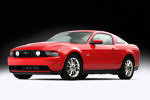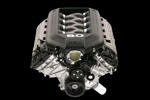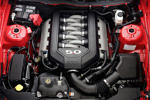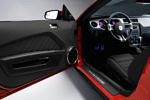Note: those of you averse to technical details about cars may want to just check out the photos of the 2011 Mustang GT and know that it will be awesome when it lands in dealership showrooms sometime next year. The rest of you should read on, as I have the official details from Ford.
Speaking of details, there have been lots of rumors, but Ford finally announced that the engine under the hood of the 2011 Mustang GT will be a 5.0-liter V8. Mustang enthusiasts all know that for many years, the Mustang GT sported a 5.0-liter V8 under its hood, and were very upset in 1996 when Ford switched to the 4.6-liter V8. In the past year, however, Ford has had the worst-kept secret engine development ever, the “Coyote” V8. Once again, Ford has an engine which displaces 302 cubic inches, matching the displacement of the previous 302 used in Mustang GTs. The Internet has been buzzing with speculation and rumors about how much power it puts out. Early this morning, Ford’s announcement came out, settling the discussion once and for all.
 5 liters. 412 horsepower. 390 foot-pounds of torque. 25 MPG highway. Everyone who’s read the rumors expected the first number, and the 2nd and 3rd numbers are close to what everyone has expected. The last number? It bests the outgoing 4.6-liter V8, and also beats the Mustang’s main rivals, the Camaro and Challenger. Meanwhile, if you print out all the stats for the three cars and compare them side-by-side, you’ll come to the same conclusion I have: The 2011 Mustang GT is going to be one majorly fast pony car. Lighter than the Camaro and Challenger, with horsepower that’s close, but not quite as high as either competitor, the new Mustang GT could very well best its rivals in handling and speed, not just MPG.
5 liters. 412 horsepower. 390 foot-pounds of torque. 25 MPG highway. Everyone who’s read the rumors expected the first number, and the 2nd and 3rd numbers are close to what everyone has expected. The last number? It bests the outgoing 4.6-liter V8, and also beats the Mustang’s main rivals, the Camaro and Challenger. Meanwhile, if you print out all the stats for the three cars and compare them side-by-side, you’ll come to the same conclusion I have: The 2011 Mustang GT is going to be one majorly fast pony car. Lighter than the Camaro and Challenger, with horsepower that’s close, but not quite as high as either competitor, the new Mustang GT could very well best its rivals in handling and speed, not just MPG.
 My take on the 2011 Mustang GT is that it will be a solid performer. Look for it to run the quarter mile in about 12.9 seconds, which is a little more than half a second quicker than the 2010 Mustang GT. While this is only a tenth of a second quicker than the Camaro, it’s far faster than the Challenger. The handling will probably be similar to current Mustangs, but expect faster overall times on a race track, due to the massive increase in horsepower over the 2010 Mustang, which goes from its current 315 hp / 325 ft. lbs. torque to the aforementioned numbers of 412 hp / 390 ft. lbs. torque. Starting in the 2012 or 2013 model year, I would expect to see the 5.0-liter V8 in any of Ford’s rear-wheel drive vehicles, namely the F-Series pickups, as a replacement for their current 4.6-liter V8. A lot of the vehicles currently coming off of Ford production lines are front-wheel drive, which makes fitting them with the new V8 a challenge. Luckily, there is a rumored replacements for the aging Ford Crown Victoria, Mercury Grand Marquis and Lincoln Town Car, all of which could feature a version of this new engine. Beyond that, any rear-wheel drive SUV or crossover that Ford produces has the potential to see 5.0 badges on it, especially as part of a performance package.
My take on the 2011 Mustang GT is that it will be a solid performer. Look for it to run the quarter mile in about 12.9 seconds, which is a little more than half a second quicker than the 2010 Mustang GT. While this is only a tenth of a second quicker than the Camaro, it’s far faster than the Challenger. The handling will probably be similar to current Mustangs, but expect faster overall times on a race track, due to the massive increase in horsepower over the 2010 Mustang, which goes from its current 315 hp / 325 ft. lbs. torque to the aforementioned numbers of 412 hp / 390 ft. lbs. torque. Starting in the 2012 or 2013 model year, I would expect to see the 5.0-liter V8 in any of Ford’s rear-wheel drive vehicles, namely the F-Series pickups, as a replacement for their current 4.6-liter V8. A lot of the vehicles currently coming off of Ford production lines are front-wheel drive, which makes fitting them with the new V8 a challenge. Luckily, there is a rumored replacements for the aging Ford Crown Victoria, Mercury Grand Marquis and Lincoln Town Car, all of which could feature a version of this new engine. Beyond that, any rear-wheel drive SUV or crossover that Ford produces has the potential to see 5.0 badges on it, especially as part of a performance package.
 Those of you with a keen eye will notice a few things about the new engine. First, the alternator has been moved from its location on the 4.6-liter, allowing for a bigger and better-flowing intake manifold. Secondly, based on the instrument cluster, the red line for the new engine has been bumped by about 500 RPMs, to a full 7,000, a far cry from where the 4.6-liter was in 1996. Also, the badging on the engine says “TiVCT”, which stands for Twin Independent Variable Camshaft Timing. TiVCT is a variable camshaft technology used on many engines throughout domestic and foreign makes, and improves performance and fuel efficiency, not that most Mustang owners will notice or care. There are of course a myriad of other differences between the old and new engines, but suffice it to say the new engine is one of very high content, with almost all of today’s engine technology in use. The only thing which is missing is Direct Injection (DI), and that’s probably because development of this engine began two years ago, before DI technology became mainstream. I would expect that in another couple of years, or just in time for the debut of the 2013 or 2014 Mustang (2014 being rumored as the when the next Mustang will be introduced), we will see DI on the Mustang, for another bump in power and efficiency.
Those of you with a keen eye will notice a few things about the new engine. First, the alternator has been moved from its location on the 4.6-liter, allowing for a bigger and better-flowing intake manifold. Secondly, based on the instrument cluster, the red line for the new engine has been bumped by about 500 RPMs, to a full 7,000, a far cry from where the 4.6-liter was in 1996. Also, the badging on the engine says “TiVCT”, which stands for Twin Independent Variable Camshaft Timing. TiVCT is a variable camshaft technology used on many engines throughout domestic and foreign makes, and improves performance and fuel efficiency, not that most Mustang owners will notice or care. There are of course a myriad of other differences between the old and new engines, but suffice it to say the new engine is one of very high content, with almost all of today’s engine technology in use. The only thing which is missing is Direct Injection (DI), and that’s probably because development of this engine began two years ago, before DI technology became mainstream. I would expect that in another couple of years, or just in time for the debut of the 2013 or 2014 Mustang (2014 being rumored as the when the next Mustang will be introduced), we will see DI on the Mustang, for another bump in power and efficiency.
 It is definitely an exciting time to be a fan of the Ford Mustang. Last year we saw a refreshing, with better-looking sheet metal and a far better interior, and this year we get all new engines, including the V6. Ford definitely has the upper hand in the battle for best pony car, and with extra oomph behind it, the Mustang looks to stay there.
It is definitely an exciting time to be a fan of the Ford Mustang. Last year we saw a refreshing, with better-looking sheet metal and a far better interior, and this year we get all new engines, including the V6. Ford definitely has the upper hand in the battle for best pony car, and with extra oomph behind it, the Mustang looks to stay there.
Shortly before posting this, videos surfaced on YouTube featuring the 2011 Mustang GT and its new engine, respectively, so enjoy!
While the pictures and video above are good, check out the gallery below for more snapshots:
by John Suit
Source: Ford








